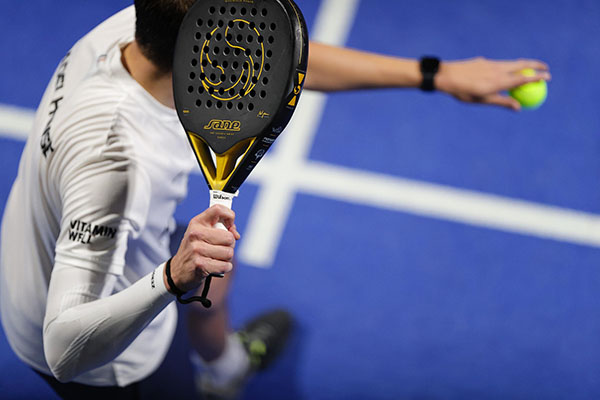The RGFT Method for Padel: A Comprehensive Rotational Performance and Joint-Protection System for One of the Fastest-Growing Paddle Sports in the World
Padel is a sport defined by dynamic movement, multidirectional rotation, rapid acceleration, explosive overheads, and reactive play off the glass walls — all performed with a short-handled paddle that requires precise body control. Because the court is smaller and rallies are longer than tennis, players generate more rotational volume per point and endure greater repetitive stress on the hips, spine, shoulders, and elbows.
This is exactly why the Rotary Ground Force Training™ (RGFT) Method—powered by the TrueTurnPro thoracic isolation system—is a breakthrough for Padel athletes. It teaches players to rotate efficiently from the ground up, stabilize the upper kinetic chain, and protect the joints that are most vulnerable in this sport.
Why Rotation Defines the Game of Padel
Padel looks simple at first glance — but mechanically, it’s a rotationally intense, momentum-driven sport with unique demands.
Every major action in Padel is rotational at its core:
The forehand and backhand rely on hip–torso rotation more than arm leverage
- The bandeja, vibora, and overhead smash require powerful rotational loading and unloading
- The volley game depends on micro-rotational control in tight spaces
- Wall play forces players to rotate reactively, often from awkward positions
- Direction changes, sprints, and split-steps demand rotary stability at high speed
- the wrist overworks
- the elbow absorbs stress
- the shoulder fatigues
- players lose precision
- players slow down on recovery
- joint strain accumulates quickly
Why Rotation Defines the Game of Padel
Padel looks simple at first glance — but mechanically, it’s a rotationally intense, momentum-driven sport with unique demands.
Every major action in Padel is rotational at its core:
The forehand and backhand rely on hip–torso rotation more than arm leverage
- The bandeja, vibora, and overhead smash require powerful rotational loading and unloading
- The volley game depends on micro-rotational control in tight spaces
- Wall play forces players to rotate reactively, often from awkward positions
- Direction changes, sprints, and split-steps demand rotary stability at high speed
- the wrist overworks
- the elbow absorbs stress
- the shoulder fatigues
- players lose precision
- players slow down on recovery
- joint strain accumulates quickly

The Breakthrough: Locking the Upper Kinetic Chain
The most powerful element of the RGFT Method is the ability to lock and stabilize the upper kinetic chain—the shoulders, arms, and hands—while driving rotation from the hips, core, and thoracic spine.
This is transformative for Padel athletes for two reasons:
1. More Efficient, More Powerful, More Repeatable Swing Mechanics
Padel players often compensate with the arms and wrist because the short paddle and tight spacing invite “arm-heavy” strokes. Locking the upper chain teaches the body to:- stop muscling the ball
- stop overusing the wrist and elbow
- stop twisting through the lower back
- stop collapsing posture during rapid wall exchanges
- stop losing shoulder stability during overhead preparation
2. Dramatically Reduced Stress on Shoulder, Elbow, and Wrist
Because Padel encourages frequent volleys, rapid transitions between forehand and backhand, and constant overhead preparation, the upper limbs are at high risk for overuse. Locking the upper chain reduces the load placed on:- the wrist (common tendinitis and strain)
- the elbow (including “padel elbow,” like tennis elbow)
- the shoulder (rotator cuff stress, impingement, instability)
Why This Matters for Padel Players
Padel rallies are longer. The court is smaller. Time between strokes is shorter. This means small inefficiencies are exposed quickly and magnified over the course of a match. When rotational control is poor:- players lose power on smashes
- volleys become unstable
- the bandeja and vibora lack precision
- players slow down on recovery
- form collapses under fatigue
- injury risk rises dramatically
- joint irritation becomes chronic
With the RGFT Method, Padel players develop:
- better balance during wall rebounds
- cleaner, more consistent forehands and backhands
- more controlled volleys at net
- a more powerful and safer overhead game
- quicker recovery steps after wide balls
- improved postural endurance during long rallies
- reduced overuse in the wrist, elbow, and shouldera more efficient, sustainable rotational engine
How RGFT Helps You Play Better Padel
Padel requires the ability to combine explosiveness, control, and reactive skill — all under rotational fatigue. RGFT enhances the physical foundation needed for high-level performance:
- More power with less effort: By rotating from the ground up, players hit harder without muscling the paddle.
- Better control at the net: Small rotational adjustments become more precise, improving volleys and touch shots.
- Stronger, safer, more confident overheads: The bandeja and vibora become smoother, more accurate, and less taxing on the shoulder.
- Improved wall recovery and rebounding control: Rotational stability makes awkward positions feel more natural and controlled.
- Superior endurance in long rallies: The body maintains structure, posture, and accuracy deep into the match.
- Safer, cleaner mechanics under fatigue: Late in matches, players maintain form rather than breaking down.
The RGFT Advantage: Performance + Longevity for Padel
What makes the RGFT Method uniquely valuable is that it enhances performance and protects the body simultaneously:Performance Benefits
- increased rotational power
- faster movement and recovery
- improved balance and coordination
- more accurate ball striking
- greater stability at the net
- smoother overhead mechanics
- better control in tight wall play
Longevity Benefits
- reduced stress on shoulders, elbows, and wrists
- less lower-back strain
- improved hip and spine alignment
- fewer chronic overuse injuries
- stronger joint stabilization
- more sustainable training and match play
In Summary
The RGFT Method for Padel trains the body to rotate powerfully, efficiently, and safely — exactly the way Padel demands.
By stabilizing the upper kinetic chain and optimizing ground-up rotation, players gain:
- more power
- more control
- more precision
- more athletic fluidity
- fewer injuries
- greater longevity
- and a significantly higher level of performance
